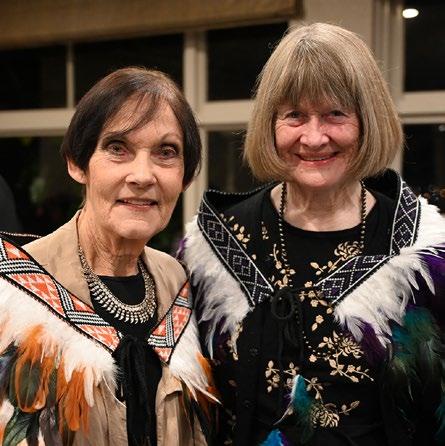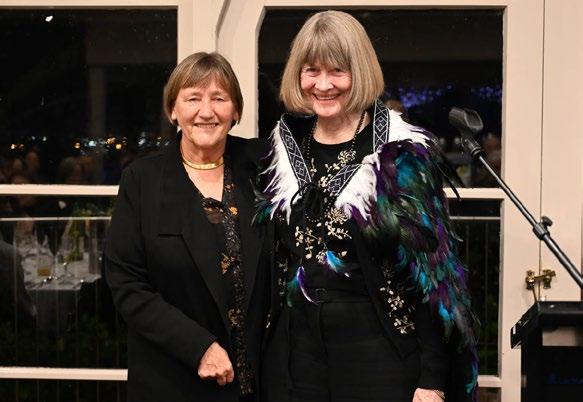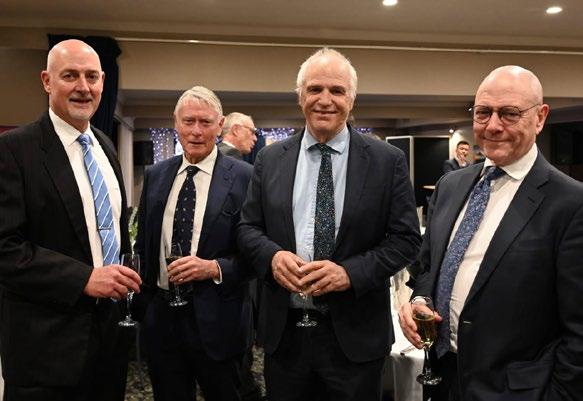When are gifts


When are gifts

LawNews is an official publication of Auckland District Law Society Inc. (ADLS).
Editor: Jenni McManus
Publisher: ADLS
Editorial and contributor enquiries to: Jenni McManus 021 971 598 Jenni.Mcmanus@adls.org.nz
Reweti Kohere 09 306 3997 Reweti.Kohere@adls.org.nz
Advertising enquiries to: Darrell Denney 021 936 858 Darrell.Denney@adls.org.nz

All mail to: ADLS, Level 4, Chancery Chambers, 2 Chancery Street, Auckland 1010 PO Box 58, Shortland Street DX CP24001, Auckland 1140, adls.org.nz
LawNews is published weekly (with the exception of a small period over the Christmas holiday break) and is available free of charge to members of ADLS, and available by subscription to non-members for $140 (plus GST) per year. To subscribe, please email reception@adls.org.nz.
©COPYRIGHT and DISCLAIMER Material from this publication must not be reproduced in whole or part without permission. The views and opinions expressed in this publication are those of the authors and, unless stated, may not reflect the opinions or views of ADLS or its members. Responsibility for such views and for the correctness of the information within their articles lies with the authors.
Cover: Maryna Terletska / Getty Images
New Zealanders have enjoyed relative freedom to make gifts without tax consequences since the abolition of gift duty in 2011.
This, combined with the abolition of estate duty in 1992, has meant it has been possible to make gifts of cash or other assets without a tax cost for the past 12 years. Of course, this lack of tax cost is subject to some exceptions, of which perhaps the most well-known is the bright-line test, which taxes certain (deemed or actual) capital gains derived in relation to real estate.
However, there are lesser-known provisions of the Income Tax Act 2007 (ITA) that can apply to tax gifts in certain circumstances. Inland Revenue (IR) has released its view on when these provisions apply in a draft interpretation statement Income tax: Income – when gifts are assessable income. The statement is accompanied by a fact sheet that summarises the statement. Both are open for feedback until 18 September 2023.
As the introduction to the statement acknowledges, “[a] gift is not usually subject to income tax”. However, the statement sets out the view of the Commissioner of Inland Revenue as to when a gift will be assessable income (and therefore taxable), under Part C of the ITA. The statement provides that a gift may be assessable income where it is:
■ received in connection with employment;
■ from a business or profit-making activity;
■ received in undertaking a voluntary activity (if it is not a reimbursement of expenditure); and ■ income under ordinary concepts. The statement applies to monetary gifts and to non-monetary gifts that are convertible to money. However, it does not apply to gifts that may be subject to fringe benefit tax or that are not subject to income tax but may be family scheme income under the Working for Families regime.
The statement notes that an amount received by a person will be employment income if it comes within section CE 1(1) of the ITA. That section sets out various types of income commonly received in connection with employment or service.
An employment relationship relevant to the person receiving the gift, whether it is a past, present or future relationship, will raise a question as to whether the gift is assessable income. However, such a relationship will not always in and of itself indicate that the gift is assessable income.
The statement summarises the main themes that indicate a gift is employment income as follows:
■ The amount of the payment reflects the extent of the services the taxpayer has provided to which the payment can be related.
Continued on page 04
For a gift to be non-taxable to a business, it needs to be unexpected, unsolicited and have no clear connection with the business activity
Case law has held that gifts and other voluntary payments can be income for taxation purposes, despite the voluntary nature of the payment
Continued from page 03
■ The payment is made as a quid pro quo in the hope of future services from the employee or to encourage further efforts.
■ The payment is a product of, or contemplated by, the terms or implied terms of the recipient’s employment agreement. However, a payment made under the terms of an agreement separate from the employment agreement may still be treated as employment income.
■ The payment had recurred or has a foreseeable element of recurrence, rather than being a one-off payment.
■ The employee’s services to which the payment can be related are commonly within the range of duties expected of the employee or the range of activities the employer carries out. However, if an employee willingly does something beyond his or her usual duties and is paid for that, their employment duties are enlarged to encompass it.
■ Such payments (including tips or gratuities) are expected or asked for or are commonplace as a matter of practice in the occupation, profession or industry.
■ The payment is one commonly provided to the recipient, not as a personal gift but because he or she is the employee who is the current holder of an office.
The statement also lists factors that indicate a gift is not employment income and factors that are not necessarily relevant (being that the employment is unpaid, and the recipient had to be an employee to receive the payment).
It is probably more intuitive that gifts made to businesses and other forms of profit-making activity are considered taxable income.
The statement confirms that gifts are considered business income or income from a profit-making activity when they are a financial product of the business or profit-making activity.
In other words, if the gift is intended to support or enhance the business activity being carried on it will be taxable. This is consistent with fundamental principles in the ITA that tax income is derived from a business (section CB 1) and from carrying on a profit-making undertaking or scheme (section CB 3).
It is also consistent with relevant case law which has held that gifts and other voluntary payments can be income for taxation purposes, despite the voluntary nature of the payment.
What is key for a gift received by a business is the reason it was made. If the payer of the gift has an interest in the continuity of the business in question and wants to assist it, then this will lead to a conclusion that the gift is taxable as there is a direct link between the reason the gift is being made and
the continuance of the business activity.
Businesses and income-earning activities inherently exist to make a taxable profit. This differs from charitable organisations or activities carried on for personal or other non-incomeearning purposes.
So, it stands to reason that gifts received by a business will often be made to further its profit-making activity and therefore it is appropriate to tax them.
But IR recognises this will not always be the case and has listed in the statement several factors that will be indicative of a gift not being taxable to a business. These include:
■ the gift being unexpected or unsolicited;
■ the gift being made in respect of past services that have been fully remunerated already;
■ the business had ended at the time of the gift;
■ the calculation of the gift is not linked to trading between the parties; and
■ the parties undertake no correspondence, bargaining or negotiations with each other.
So, for a gift to be non-taxable to a business, it needs to be unexpected, unsolicited and have no clear connection with the business activity being carried on.
An example might be an unexpected gift from a philanthropic donor who has an interest in the nature of the business but who otherwise has no relationship with it.
Also relevant is whether the business or income-making activity is carried on by an individual. Where this is the case, it may be easier to establish that the gift is being made out of natural love and affection, or perhaps esteem or respect for that individual, as compared to a gift made to a company owned by a number of shareholders.
All of this means that businesses in the fortunate position of receiving a gift must carefully consider all the facts surrounding receipt of the gift to establish why it was made and whether this will cause it to be treated as taxable.
It is more surprising that gifts made in connection with voluntary activities can also be taxable. This is, however, clearly contemplated in section CO 1 of the ITA which deems an amount derived by a person to be taxable income unless the payment is reimbursing a volunteer for expenditure incurred by him or her in undertaking the activity.
Under section CO 1, a gift is taxable to the recipient if the gift and the recipient have a sufficient connection. In Inland Revenue’s view, factors such as the following will indicate this sufficient connection exists:
■ the amount of the gift is commensurate with the recipient’s
Continued on page 05
An employment relationship relevant to the person receiving the gift, whether it is a past, present or future relationship, will raise a question as to whether the gift is assessable income
Continued from page 04

personal exertions in undertaking the voluntary activity;
■ the gift is made in the hope that the recipient will undertake future activities;
■ the gift has recurred or is likely to recur; and
■ gifts are commonplace and/or expected in undertaking the type of voluntary activity in question.
So, if there are factors that indicate that the payment is not in substance a gift, but more in the nature of compensation for effort or an attempt to encourage future effort, it is treated as income. This is on the basis that it is compensating a person for their activities and therefore has an income flavour to it.
Conversely, if a gift is clearly made on the basis of personal goodwill and is received when the voluntary activity is not being undertaken, then this will be indicative that it is not taxable as it is not linked to the performance of any activity.
New Zealand has a strong culture of volunteering and numerous organisations exist that rely on the efforts of volunteers to function. While small gifts to volunteers to express appreciation and thanks are not taxable, care must be taken if they become regular and linked to the amount of effort that a volunteer has put in, to ensure such payments are not viewed as taxable compensation for services.
The final category of taxable gifts covered by the statement is gifts that are income under ordinary concepts, under section CA 1(2) of the ITA. This sub-section is a catch-all that generally applies only if another specific section of Part C does not apply to deem an amount as income.
“Income under ordinary concepts” is not defined in the ITA and is interpreted in accordance with case law. The statement notes the following features will indicate a gift is income under
ordinary concepts:
■ The series of gifts fulfils the notion of an “income”. That is, the gifts have the necessary periodicity and the payer makes them for the recipient to rely upon or intends the recipient to rely on them for regular living expenses and they are so relied upon by the recipient.
■ The necessary periodicity of the payments refers to payments made with such regularity, recurrence, amount and frequency that they amount to an “income”.
■ The payments are periodic and made with the intention of providing an income when they began (or this has been established over time) to the extent that the recipient could reasonably have expected to rely on the payments for his or her living costs.
■ The recipient relies on the payments for financial support.

■ The payments are connected with some activity or personal exertion of the recipient, even though that exertion or activity does not necessarily arise in the context of an employment relationship (past, present or future) and does not amount to a business or a profit-making activity.
The statement is 59 pages long and contains comprehensive legislative and case law analysis. While the taxation of gifts might seem straightforward, there can clearly be many pitfalls if a gift extends beyond a true voluntary payment into something that may be construed as a reward for service (either as an employee or volunteer) or is intended to assist the income-earning activities of a business.
As with any tax issue, the devil is always in the detail and a clear understanding of all facts and circumstances is needed to determine the correct tax treatment. ■

The lack of tax cost is subject to some exceptions, of which the most wellknown is the bright-line test
Qualifying couples are empowered by s 21 to contract out of the Act’s equalsharing property rule, by agreeing to arrange the status, ownership and division of their relationship property however they like
Shortland Chambers barrister Nura Taefi, at a recent ADLS CPD webinar Lawyering for 21st century relationships presented by Taefi and Hesketh Henry partner Mary Joy Simpson.
“It’s something that is already happening …. We hear about [polyamorous relationships] more now, but they’ve been around for some time,” Taefi said.
“I’ve spoken to practitioners who have been preparing s 21 agreements for their clients in polyamorous relationships, unsure if they were going to be enforceable and sometimes, therefore, entering into other types of agreements. So, to some degree, the decision gives practitioners a little bit more certainty about how to approach them and that they can use s 21 agreements.”
The Supreme Court in Mead discussed for the first time whether the Act could even apply to polyamorous relationships.
Two significant Supreme Court decisions are changing the way lawyers advise on modern relationships and property rights. The cases, Sutton v Bell and Mead v Paul, will also drive practitioners to draft new clauses in s 21 contracting-out agreements that reflect the court’s recent judgments.
Both cases, released in June, are forcing lawyers to grapple with how to apply the Property (Relationships) Act, passed in 1976 and updated in the early 2000s, to relationships in the 21st century.

In Sutton, a unanimous bench clarified the application of s 44 of the Property (Relationships) Act (PRA) to pre-relationship dispositions of property, while a majority of judges in Mead v Paul held the Act could apply to non-exclusive relationships.
The possibility of contracting-out agreements signed by people in relationships of more than two individuals is real, said
Brett and Lilach Paul married in 1993 and met Fiona Mead at the turn of the millennium. For 15 years, beginning in 2002, the trio were in a “triangular polyamorous relationship”. They were free to love others, but their primary relationship was between the three of them. Mead was the legal titleholder of the property they shared. Each party contributed to the household.
Lilach Paul separated from Mead and Brett Paul in November 2017 and Fiona and Brett separated in early 2018. Lilach Paul claimed one third of the parties’ family home but Mead objected on the basis that the trio’s relationship didn’t come under the PRA. Brett Paul supported Lilach Paul’s position and sought a declaration that the overall relationship could be divided into three constituent couples for the purposes of property division.
Continued on page 07
Continued from page 06
The High Court found in Mead’s favour, while the Court of Appeal found for Lilach and Brett Paul. The sole issue before the Supreme Court was whether the PRA could apply – a matter of jurisdiction for the Family Court, which would ultimately determine how the statute applied.
Justices Mark O’Regan, Joe Williams and Stephen Kós, who wrote the majority decision, dismissed Mead’s appeal. While a triangular relationship could not itself come under the PRA, a de facto relationship didn’t have to be exclusive to be a qualifying relationship. Inherent to all multilateral relationships were groupings of couples, which meant a triangular relationship, with mutual cohabitation and sexual relations, could be divided further into three qualifying relationships.
Justices Susan Glazebrook and Ellen France dissented, saying the majority’s treatment of the throuple as subdivisible was artificial and effectively ignored the way in which the trio saw their relationship and conducted their lives. Given the PRA was premised on coupledom, Parliament was better placed to decide whether to bring non-exclusive relationships within the Act.
Qualifying couples are empowered by s 21 to contract out of the Act’s equalsharing property rule, by agreeing to arrange the status, ownership and division of their relationship property however they liked.
So, would parties to a polyamorous relationship have three separate agreements or one agreement that all three signed? Taefi, who was counsel for Lilach Paul, said acknowledging each constituent relationship would be necessary, but one agreement could do it effectively. Equally, a couple might have to amend an existing s 21 agreement to take account of a third person who joined their relationship.
Another example involved an existing property relationship agreement between two people, except one of the partners then formed a separate relationship with a third person. Taefi said Mead had implications for this kind of relationship, or “vee arrangement”, as the Supreme Court had confirmed that coupledom didn’t have to be exclusive.
“You can’t say to your mistress, ‘Well, we don’t have a de facto relationship because you’ve always known I have a wife’. That de facto relationship needs to be looked at on its own and in its own right. It doesn’t take away from that de facto relationship, that there’s another relationship.
“Of course, you still have to meet the standard for mutual commitment to a shared life and have the other [section] 2D factors. But you can’t rely on the existence of another relationship to undercut the second,” she said.
Practically, having two separate agreements might make sense, Simpson said. “But I could imagine situations where one partner is asking to see this s 21 agreement that’s also been made with the other partner. So, having visibility over both agreements that are in place and having one agreement contingent on the other also standing – that might be important as well.”
Simpson said in applying the Act to non-exclusive relationships, “you’re always having to dissect it to make two and you’re ignoring one person in the relationship for the purposes of [property division]. It doesn’t fit, does it?”
Taefi said while it couldn’t be denied that the Act is focused on couples,
Continued on page 17
Get the best of both worlds with top-quality work and life by the beach!
Holland Beckett Law is a progressive and growing full-service law firm, situated in the sunny Bay of Plenty with offices in Tauranga, Rotorua and Whakatane. With over 130 employees, it is one of the largest provincial practices in New Zealand.

We are looking for Solicitors to join our busy Litigation and Commercial/Property Teams based in Tauranga.
What we are looking for:
• Strong client service orientation and a desire to add real value to every client interaction;
• Strong work ethic;
• Excellent communication, written and technical skills; and
• Down-to-earth and collaborative interpersonal style.
Commercial/Property
• NZ-admitted lawyer with 2-4 years’ PQE.
• Property experience with demonstrated commercial nous. Trust and estate planning knowledge would be useful.
Litigation
• High academic achievements, ideally an Honours degree or LLM.
• 4 to 8 years’ PQE litigation experience from a national firm or as a judge’s clerk.
In return we offer:
• Flexible work arrangements;
• A great culture with regular social events;
• A wellness-focused firm, offering an innovative wellness package;
• Community focus including pro bono legal work, team-based community service days, and an employee-driven charitable trust fund;
• Access to leading technology;
• Employee support and career initiatives such as mentoring schemes and coaching; and
• A generous and supportive parental leave policy and entitlements.
If you are seeking an opportunity to take the next step in your legal career, whilst maintaining a wonderful lifestyle in the Bay of Plenty, then please send a copy of your cover letter, CV and academic transcript to careers@hobec.co.nz
Hugh Catherwood, a life insured under an Asteron life insurance policy, sought payment of a death benefit on the grounds that he was terminally ill with a life expectancy of less than 12 months.
Asteron declined cover because the insured was being treated and therefore expected to live longer. Catherwood sued, arguing that the treatment should not be taken into account (Catherwood v Asteron Life Limited [2021] NZHC 2612 and Catherwood v Asteron Life Limited [2023] NZCA 357).
Unsurprisingly, both the High Court and the Court of Appeal agreed with the insurer, concluding that it was right to take the treatment into account and therefore to decline cover.
In reaching its decision, the Court of Appeal made a number of broader observations about the interpretation of insurance policies more generally.
Catherwood’s policy with Asteron provided for both trauma and life cover. Under the trauma cover, an insured is entitled to payment of a trauma benefit if he or she undergoes major surgery and survives for at least two weeks. Catherwood had approximately $565,000 of trauma cover.
Under the life cover, an insured is entitled to payment of a death benefit it he or she becomes “terminally ill”. This occurs if the insured’s “life expectancy is, due to sickness and regardless of any available treatment, not greater than 12 months”.
Catherwood’s death benefit was approximately $1.2 million.
Catherwood was diagnosed with a tumour at the top of his stomach in January 2019. He was treated with eight weeks of chemotherapy, surgery to remove part of his stomach and oesophagus and a further eight weeks of chemotherapy.
Catherwood claimed under his trauma cover. Asteron accepted that claim, and paid him $565,000.
Once he had received his trauma payment, Catherwood then claimed under his life cover, arguing that the assessment of his life expectancy should be undertaken “regardless of any available treatment”. He said this meant the effect of any available treatment should be ignored and the evidence was that, in the absence of any treatment, he would have likely died in the 12 months following diagnosis.
Asteron declined the claim, saying that Catherwood needed to have a life expectancy of less than 12 months even after any available treatment. It said “regardless of any available treatment” means “despite any available treatment”. The evidence was that, taking into account the treatment, Catherwood’s chance of dying in the 12 months following diagnosis was less than 10%.
The Court of Appeal rejected Catherwood’s interpretation of the policy. It accepted that the policy was “not well worded” and that the words “regardless of” could mean either “ignoring
Continued on page 09
It is not enough that the words themselves are ambiguous
Continued from page 08
the effect of” (as contended by Catherwood) or “despite the effect of” (as contended by Asteron).
This then raised an important question: how does the court interpret words in an insurance policy where those words are capable of bearing two different meanings?
In this case, the court considered three different approaches: ■ looking at the broader context in which the words are used in the policy; ■ applying the contra proferentem rule; and ■ considering the approach used in other policies in the market.
The Court of Appeal ruled that, under the modern approach to contract interpretation, it was appropriate to consider the context in which the words were used. It said this context supported Asteron’s interpretation.
The argument that an insured can claim a death benefit for a terminal illness in circumstances where there is an available cure and the insured is likely to survive is contradictory. It gives no meaning to the “terminal” in “terminal illness”, the court said.
And there were other options under the policy (such as the trauma cover) for conditions falling short of death.
In our view, this is clearly correct. No reasonable person would understand the terminal illness cover to apply in circumstances where the insured is in fact likely to survive for more than 12 months.
The Court of Appeal accepted that the definition of terminal illness was “ambiguous” because the words “regardless of” can bear two different meanings.
However, the court rejected Catherwood’s argument that this invoked the contra proferentem rule, namely that where a policy is ambiguous, it must be construed against the party who drafted it.
While the court accepted that the rule can be of use in interpreting insurance policies, it concluded the rule did not apply here because the court considered there was “no ambiguity as to the proper interpretation of the definition”.
In our view, this is a helpful explanation of the way the contra proferentem rule applies. It is not enough that the words themselves are ambiguous. It must be the case that, even after considering the broader context, there is still an ambiguity about the proper interpretation of the policy.
The High Court admitted evidence that other insurance policies in the market had terminal illness benefits that apply after taking into account available medical treatment, although the court did not rely on that market evidence in interpreting the policy. Catherwood challenged the admissibility of that evidence.
The Court of Appeal commented briefly on the admissibility issue, saying evidence of industry practice “speaks to the general context within which Mr Catherwood’s contract was entered into”, and that the evidence was therefore properly admissible in this case. ■
David Friar is a partner and Liam McNeely is a senior associate at Bell Gully ■
Woodward Chrisp is a well-established Gisborne legal firm of 40+ working in spacious offices, with modern technology and a supportive team environment. While we value hard work, we are people-focused and try to ensure all staff have time to enjoy a good work/life balance.
The position is ideally suited to a person who appreciates all that living in a small city with its relaxed lifestyle has to offer, with its sun, surf and great outdoors in near proximity. We are looking for a Senior Solicitor, but would also welcome to the team a solicitor with a couple of years’ experience.
You will have the determination and drive to continue your career in a full-service legal firm, joining our family team in a busy practice with lots of opportunity for court time.
You will have an interest, and/or experience, in the following areas – parenting, relationship property, asset protection, challenging a will, incapacity, paternity, domestic violence and mediation.
Our family team consists of four solicitors and two support staff. Our senior lawyers are able to provide support and mentoring in areas where you may need to get up to speed.
What we expect from the ideal candidate:
• A positive and enthusiastic attitude
• Ability to get on with a wide range of people
• Strong client-service orientation
• Must be proactive and flexible with a collaborative interpersonal style
• Able to work independently
• Great time-management skills with the ability to prioritise
• A desire to develop skills in all aspects of law
• A sense of humour
If you are enthusiastic and keen to get quickly in the thick of it, come join our fun, professional and dedicated team. Being based in the regions, we offer a broad range of experience in this hands-on role. We provide ongoing training, opportunities for professional development and a competitive salary based on experience along with fantastic social opportunities in a friendly work environment.
Any enquiries or to apply send a detailed cover letter with your CV to Cherie Mirko (cherie.m@wwclaw.co.nz). Visit www.woodward-chrisp.co.nz for more information.
of ADLS’ Employment Law committee, says the policy could empower employees, when figuring out their leave periods, to collaborate among themselves.
“If there’s an even greater trust model, it might be that employees discuss between them ‘ok, look, I’m going to take three weeks off here. Are there enough people around to cover that?’ It’s about having those collaborative conversations between colleagues, with supervisors.”
Reweti KohereNetflix does it. So do Microsoft, LinkedIn and Salesforce. And here in New Zealand, software company Actionstep and game developer Rocketwerkz have become the first local businesses to offer employees unlimited annual leave.
With only a handful of workplaces offering this perk, employment lawyers say the trust and confidence that employers and employees share will prove crucial in determining whether unlimited annual leave is more widely adopted in New Zealand.
The employment benefit, focusing on deliverables and results rather than hours worked, might not suit all industries. But for those it does, employees could be empowered to decide when, and for how long, they take leave.
Unlimited annual leave, the four-day work week, work-fromhome days and greater flexibility in work hours – workplaces have been grappling with these issues for the past three years after covid-19 pandemic restrictions suddenly foisted remote or hybrid working on businesses.
While popular overseas, unlimited annual leave is only starting to emerge in New Zealand and only a handful of businesses have adopted the policy.
Under the Holidays Act 2003, workers in New Zealand are entitled to four weeks’ paid annual leave after 12 months of continuous employment. An unlimited leave policy sits over and above this statutory benefit.
The freedom with which employees can carve up their workday however they like, and still perform well, comes back to ensuring their workplaces are environments that “can operate on a high-trust model”, says employment lawyer William Fussey.
“Which is why I can see more companies bringing on that kind of policy, but I can’t see it happening on a completely widespread basis.”
Fussey, an associate at Anderson Lloyd and a member
Tompkins Wake partner Daniel Erickson agrees. The way in which employers can keep a handle on this significant benefit will initially come down to how much they and their employees trust each other.
“You may just have to take the employee on their word that this is what they’re doing. Now, if it happened frequently or if an absence was extended, then you may be asking more specific questions at that point.”
Beyond that, prudent employers will set parameters. For example, taking annual leave must be by agreement or the employer can defer the request if it’s not in the interests of the business.
Erickson, a member of ADLS’ Employment Law committee, says the need for agreement helps bosses avoid situations where “everyone takes holidays at once or someone takes a long period of leave when they were in the middle of an important project”. Fussey adds that an unlimited leave policy should stipulate that the employer retains the discretion to grant a leave request. On the other hand, for an employer to have the discretion and yet never approve a request “makes a mockery of the idea that it’s unlimited”, he says.
“In theory, it’s unlimited, but you still need to check in with your supervisor that you can take the time off purely on the basis, say, of operational needs. So, the employee might end up taking twice as much annual leave as they would ordinarily be entitled to, but it’s an ongoing conversation with the employer around when those things happen.”
A common thread runs through the sorts of businesses
Continued on page 11
We’re moving toward a workplace environment, or at least aspirationally, where it doesn’t matter what time of the day you do your six or eight hours
When you look at the kind of jobs or industries that are doing these unlimited leave policies, they tend to be in industries where employees are really excited about coming to work
Continued from page 10
implementing the policy, Fussey says.
“When you look at the kind of jobs or industries that are doing these unlimited leave policies, they tend to be in industries where employees are really excited about coming to work, they’ve got really exciting, creative projects they’re doing. They’re chained to their work because they love it so much.
“And unlimited annual leave is kind of a way of encouraging them to take time off when they need it.”
Overseas, the likes of Netflix, LinkedIn and Visualsoft have trialled similar policies, but found most people ended up taking less leave when compared to an allocated number of days.
Closer to home, Australian innovation consultancy firm Inventium, found the average amount of leave used after 12 months was 24 days, rising to 27 days after two years. Founder Amantha Imber said the finding meant staff were taking what they needed and yet the policy wasn’t being abused as other employment benefits surrounded the business’ leave policy.
After testing the policy with all employees for a year, and in what was believed to be a New Zealand first, Actionstep recently decided to make the work-

benefit permanent. And with offices around the world, the company has instilled a minimum requirement that staff take at least four weeks off each year.
Vice president of engineering Stevie Mayhew recently told Seven Sharp the company experienced its “biggest growth ever” while its year-long trial was running, starting in May 2022. “You could say it might have cost us not to have done this.”
In a similar vein, Rocketwerkz perceived its unlimited annual and sick leave policies as compelling points of difference as it fought for talent within the competitive, high-paying IT industry.
Unlimited annual leave is part of the broader trend of greater workplace flexibility. With about 50 companies in New Zealand already using a four-day workweek roster, there’s majority support among New Zealanders for introducing the work concept more widely, according to a 1News Kantar public poll in May this year.
Flexible working hours is seen as one of the most important employee benefits in 2023. Frog Recruitment’s latest annual employment and salary report found the most common flexibility option offered is individual arrangements based on one’s role
and seniority, followed by one’s employer deciding work hours and work-from-home and office days. While flexibility remains an important motivator for jobseekers, cost-of-living pressures mean salary and pay is becoming more of a priority.
Actionstep’s average leave balance showed most staff had taken more than the statutory minimum allowance, but it wasn’t excessive.

Mayhew said the business trusted its employees to do the work needed for Actionstep to succeed, “and we want to make them be able to have good lives alongside that. It’s something we think is really important – to make sure our staff are happy. This is one of the ways we help to support them.”
Giving employees the ability to fit their work hours around their lives is having a wider impact.
“We’re moving toward a workplace environment, or at least aspirationally, where it doesn’t matter what time of the day you do your six or eight hours,” Fussey says.
“And if, on a couple of occasions, you only do three or four hours, and you’ve got unlimited annual leave, then it doesn’t really matter. That person is probably going to make up the time elsewhere because they’re working hard overall.” ■
The South Auckland Bar Association (SABA) earlier this month honoured recently retired High Court judge Ailsa Duffy KC and long-service criminal defence barrister Marie Dyhrberg KC, who in turn praised the area’s barristers for continuing to pursue “the possibility of hope”.

Also among those honoured were former Children’s Commissioner, Justice Andrew Becroft, and South Auckland barrister-turned-judge Melinda Mason.
The quartet, together with the MC, Judge Gerard Winter, lauded the bar for upholding their duties in representing people who were grappling with social deprivation and criminal offending, all the while confronting access-to-justice challenges.
With more than 100 lawyers, barristers, members of the bench, representatives of the profession and politicians in attendance, SABA’s annual event received a typically strong showing of support.
Judge Winter, having warmed up the crowd by getting everyone to sing the theme song from Rocky as he walked into the dining room, explained the origins of the word “hero” – demigods whose mortal service was done to mankind.
By this definition, heroes made up South Auckland’s bar, Judge Winter said, urging them to keep chasing all that hope could make possible.
In honouring SABA’s first guest, Judge Winter said he and Duffy shared something in common – they used to dance; she as a go-go dancer at Auckland’s Monaco Club in the 1970s, he as a ballet dancer. The
light-hearted moment contrasted with what Judge Winter described as Duffy’s fearlessness, as a lawyer and a judge, in ensuring all those who came before her were treated fairly.
Taken by surprise, Duffy thanked everyone before revisiting the speech she gave at her final sitting a month ago. There, she had said New Zealand was now a “harder, colder, more brutal place” than when she started practising law in the late 1970s.
In the lead-up to October’s general election, National has proposed a raft of justice policies, including capping judicial discretion on sentencing and restoring the controversial “three strikes” law. At the SABA dinner, attended by National’s justice spokesperson Paul Goldsmith and shadow attorneygeneral Chris Penk, Duffy doubled-down on her valedictory comments, cautioning against excluding offenders from society. Those whom society prevented from participating would turn to other kinds of heroes: gangsters, drug lords and fellow criminals.
Duffy also implored the profession to continue taking a stand against injustices. One of her heroes was Thomas Paine, the 18th century political activist who was tried and convicted of seditious libel for defending the popular political revolutions that were happening in France at the time.
With Paine moving to France before his trial, British lawyer Thomas Erskine – Duffy’s second hero – represented him in his absence. Having taken on Paine’s defence and arguing for freedom of expression and the right of people to criticise, reform and change
Continued on page 13
Showing compassion for those who might well warrant punishment, or demonstrating the ‘not-so-sugary’ concept of mercy, is vital
Those whom society prevented from participating would turn to other kinds of heroes: gangsters, drug lords and fellow criminalsMarie Dyhrberg KC and Ailsa Duffy KC
Continued from page 12
their government, Duffy said the pair exemplified the meaning of needing representation – and standing by those who needed it.
Dyhrberg said she couldn’t have imagined someone from her background – “a Catholic, working-class girl from Christchurch” – achieving all that she had, and South Auckland had played an immense part in that. She paid tribute to the area where she has spent so much of her career, including a former brothel that was once her Otahuhu office.
Justice Becroft spoke about how much South Auckland has meant to him throughout his legal

career. Described as “legendary” by SABA president Ish Jayanandan, the Māngere Law Centre was founded in 1986 by Justice Becroft and his friend and colleague, Judge Johnny Moses. The community law service was established to meet the enormous, unmet legal need that existed in the suburb in the mid-80s.
Justice Becroft said showing compassion for those who might well warrant punishment, or demonstrating the “not-so-sugary” concept of mercy, was vital. He urged the bar to continue practising the law “with courage and humility”.
In honouring Judge Mason, Jayanandan said while the South Auckland bar was all the poorer for losing her, the Tauranga bench was lucky to have gained the former barrister and co-founder of general practice firm Mason and Mortimer Lawyers. ■



Duffy implored the profession to continue taking a stand against injustice
ESTATES JUNIOR
WEBINAR

Webinar 1.5 CPD hours
Tuesday 29 August 12pm – 1.30pm
Price from $110 + GST
Presenters Alison Gilbert, partner, Brookfields and Sacha Jugum, senior associate, Brookfields

CRIMINAL ALL LEVELS WEBINAR
Webinar 1.25 CPD hours
This webinar will provide useful guidance and a practical overview of the fundamentals of estate administration, from receiving notification of a client’s death to identification of the executor(s) and the assets through to the distribution and winding up of the estate.
LINKEDIN ALL LEVELS WEBINAR

Thursday 7 September 1pm – 2.15pm
Price from $100 + GST
Presenter Anne Casey, founder and director, Marketing Minds
Webinar 1.5 CPD hours
Wednesday 6 September 5.15pm – 6.45pm
Price from $110 + GST
Presenters Samira Taghavi, barrister and practice manager, Active Legal Solutions; Trevor Ng, deputy registrar, Auckland District Court; Kristy Li, Crown prosecutor, Meredith Connell and Jerry Jiang, police prosecutor
This webinar will focus on the nuances of the Criminal Procedure Act 2011 with a comprehensive overview of the different stages involved.
Chair Judge Belinda Sellars KC
This webinar will be presented by a digital marketing expert who will give you a better understanding of why LinkedIn is important for lawyers. She will offer practical guidance on how to start using this platform effectively and will delve into strategies for optimising the benefits of being an active LinkedIn user.
LITIGATION
ALL LEVELS
WEBINAR
Webinar 1.5 CPD hours
Tuesday 12 September
5.15pm – 6.45pm
Price from $110 + GST Presenters Justice Francis Cooke; John Katz KC, Bankside Chambers and Shane Hussey, director, Hussey & Co Chartered Accountants Chair Justice Cooke

CONFERENCE
ALL LEVELS PROPERTY
In Person | Livestream
4 CPD hours
Thursday 14 September 12.30pm – 5pm
Price from $400 + GST Presenters Anita Reinecke, Ben Thomson, Clinton Baker, Dakota Panetta, David Powell, Joanna Pidgeon, Julie McLean, Kyle O’Reilly, Liza Fry-Irvine, Lloyd Gallagher, Paula Beaton, Thomas Gibbons, Tim Jones and Vicki Toan
SEMINAR
ALL LEVELS CRIMINAL
Expert evidence can make or break a case. So, if it is going to be used, it must be effective and comply with applicable rules. Yet expert evidence sometimes misses the mark or can even undermine a party’s case.


Join us at the Strata Unit Titles Conference where we are bringing together legal experts from New Zealand and beyond. This year’s conference is designed to explore the latest trends, insights and best practices through discussions and presentations. Our speakers will delve into the complexities of unit titles and help to clarify the issues.
In Person | Livestream
2 CPD hours
Wednesday 20 September 4pm – 6.15pm
Price from $140 + GST
Presenters Grant Illingworth KC, Stewart Dalley, partner, D & S Law and Warren Pyke, barrister
This seminar will cover a range of options for challenging official decisions. It aims to educate practitioners about the expanding scope of judicial review, with a particular focus upon criminal, immigration and refugee law.
Connecting New Zealand lawyers
Funding the Future (Newly Suited Lawyers)
Wednesday 30 August 5.30pm – 7pm
GHD Centre, Level 3, 27 Napier Street, Freemans Bay, Auckland
Hawke’s Bay Lawyers’ Lunch

Wednesday 20 September 12.30pm – 2pm
Lone Star Corner Marine Parade & Emerson Street, Napier
Tips & tricks for junior lawyers moving in-house




Thursday 21 September 5.30pm – 7.30pm
Duncan Cotterill, Level 1, Australis Nathan Building, 37 Galway Street, Auckland CBD
Sponsored by MAS


Christchurch After 5
Thursday 19 October 5.30pm – 7.30pm Botanic, 126 Oxford Terrace, Christchurch Central City
Learn more
November Wednesday
Soon
Continued from page 07
Lilach Paul successfully argued that pairing didn’t have to be exclusive. The s 2D factors listed in the meaning of de facto relationship were flexible and designed to apply to a range of relationships.
“And there’s nothing actually in the wording of s 2D that says these relationships have to be exclusive. So, that would be reading something into the Act that’s not there already. But you can see the argument goes both ways,” she said.
While Parliament wasn’t necessarily contemplating three-way relationships in 2001 when it introduced de facto relationships to the Act, Taefi said lawmakers needn’t have at the time.
“What it did was design this flexible [s] 2D test that could be applied to all kinds of relationships. And we know now, having had this Act with all these changes for 22 years, there’s an enormous diversity in human relationships.”
The Sutton decision was significant because it made clear the interplay between the Act and dispositions of property before a de facto relationship has begun.
Section 44 of the Act empowered a court to set aside one party’s transfer, sale, gift or other form of disposition of property made with the intention of defeating another person’s claim or rights under the PRA.
Having met in July 2003, Todd Sutton and Joanna Bell were in a de facto relationship for some seven and a half years and had two children together. Just before their de facto relationship started, Sutton transferred his former matrimonial home to a trust. After the duo separated in 2012, they differed on whether the transferred property formed part of their
relationship property.
Claiming half of the property, Bell argued Sutton had transferred it to defeat her PRA rights. Sutton argued that as Bell had no such claim at the time of the transfer, he couldn’t have intended to defeat her rights.
Bell succeeded in the lower courts. The Supreme Court followed suit – s 44 could apply to dispositions made before a de facto relationship started, the provision should apply when parties have a “clear and present intention” to form such a relationship and Sutton knew the property transfer would defeat Bell’s future PRA claim.
‘We met on this date’ Simpson said entering new relationships was another important reason to have a s 21 agreement. A new clause specifying when de facto partners began contemplating that they were in a de facto relationship should start to appear in such agreements. As Taefi put it, “‘We met on this date, we were in contemplation of a de facto relationship on this date and we agree the de facto relationship commenced on this date’.”
Determining whether parties’ had the requisite clear and present intention would be neither simple nor straightforward.
“Unfortunately, we don’t sign a piece of paper or write it up or say what it is,” Simpson said. “It would be nice in a property relationship agreement to be saying the people were in contemplation of a relationship at this point in time, but that’s a difficult thing to advise on and to have your client commit to in writing as well because it’s not an easy thing to assess.”
Taefi highlighted another complexity. “Some people might be in contemplation of a de facto relationship on their first date and some may never be in contemplation of a relationship,” she said. “Unlike a marriage, which you enter intentionally, a lot of people unintentionally find themselves in a de facto relationship such that those people probably are never in contemplation of it until it’s really happened.”
The impact of the Sutton ruling would be felt widely, Taefi said. “We are now, in some cases, going to be looking at ‘were they or weren’t they in contemplation of a de facto relationship?’”
Simpson added that care would be needed in the wake of people tidying up their affairs upon leaving a relationship.
“You have trusts where there might not have been gifting completed, you’re having to exit people from trusts and restructure things, create new trusts – all these things that you prefer to do in times when there’s not a potential s 44 application able to be brought,” she said.
“But, at the same time, people are rearranging their personal lives as well and entering new relationships. So we’re just going to have to take care to educate clients.” ■
Missed ADLS' Lawyering for 21st century relationships seminar? Purchase the On Demand course now. ■
NEW EDITION
 Author Iris Reuvecamp
Author Iris Reuvecamp
This work is designed as a guide for lawyers and professionals who navigate the Protection of Personal and Property Rights Act 1988 on a regular basis. It covers personal orders, property orders, applications, procedure, the impact of the UN Convention on the Rights of People with Disabilities, appeals and enduring powers of attorney.
Price for ADLS members $126 plus GST*
Price for non-members $140 plus GST*
(* + Postage and packaging)
To purchase this book please click here or visit https://adls.org.nz/bookstore/ or contact the ADLS bookstore by phone: 09 306 5740, or email: thestore@adls.org.nz
While a triangular relationship could not itself come under the PRA, a de facto relationship didn’t have to be exclusive to be a qualifying relationship




If you are looking at selling your Law Practice and are curious about the value of your business call me today for a confidential discussion.
Nick Stevens 021 641 978 nick.stevens@linkbusiness.co.nz

Please refer to deeds clerk. Please check your records and advise ADLS if you hold a will or testamentary disposition for any of the following people. If you do not reply within three weeks it will be assumed you do not hold or have never held such a document
LawNews: The no-hassle way to source missing wills for $80.50
Following some barristers retiring, we have three offices of varying sizes available for rent.
The Chambers share a refurbished floor (with separate areas) with Hussey & Co., a boutique forensic and general accounting firm. There are shared meeting rooms (a formal boardroom with video conferencing facilities and a less formal meeting room), and communal entrance and client waiting area.
Telephones, internet connection, printing and secretarial services also available and some furniture available.
Cost depends on office size and range from $150 – $300 per week plus gst. No long-term commitment required.
Photographs of the Chambers can be viewed at www.hco.co.nz/gallery.
Contact: Shane Hussey for further details, Shane@hco.co.nz
• Late of Auckland
• Cabinet maker
• Aged 60 / Died 08’08’23

SENIORS $30 GROUPS 10+ $25
• Late of 249 Run Road, RD 7, Wellsford
• Separated
• Aged care worker

• Aged 61 / Died 27’07’23
Anderson Lloyd have a number of experienced independent investigators, including two AWI-Certificate holders, available to conduct workplace investigations for your clients. Our investigators have significant experience conducting workplace-based investigations in the private and public sector, including:
sexual harassment and sexual bullying and harassment
conflicts of interest and corruption investigations
• serious misconduct investigations

• whistle-blower investigations
• sexual misconduct investigations
• education disputes investigations
• health and safety investigations
We pride ourselves on being responsive and flexible to meet your clients’ needs. We are a regular referrer of workplace investigation work, and welcome collaborating with other lawyers who also both conduct and advise on workplace investigations.
To find out more visit al.nz or contact:
(AWI-CH) ashley-jayne.lodge@al.nz | +64 27 233 4650
(AWI-CH) john.farrow@al.nz | +64 27 437 2131 james.cowan@al.nz | +64 3 471 5415
